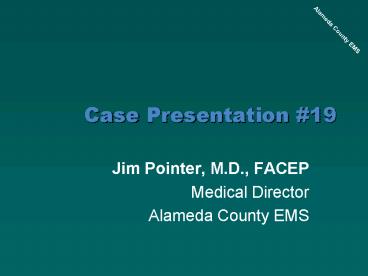Case Presentation - PowerPoint PPT Presentation
1 / 27
Title:
Case Presentation
Description:
Motor 4. Alameda County EMS. Focused H & P ... associated with motorized scooters. 6 year old boy ... Children 5 should not use skateboards or scooters ... – PowerPoint PPT presentation
Number of Views:84
Avg rating:3.0/5.0
Title: Case Presentation
1
Case Presentation 19
- Jim Pointer, M.D., FACEP
- Medical Director
- Alameda County EMS
2
The Call
- You respond to a 9-1-1 call on a busy suburban
street for traumatic injury. Your patient, a
seven year-old male, is lying prone on the street
with his head nodding in confusion. An electric
microscooter lies on its side in the middle of
the street.
3
Initial Assessment
- ABCs
- Airway open
- Breathing labored
- Circulation no bleeding
- Glasgow - 9
- Eyes 2
- Verbal 3
- Motor 4
4
Focused H P
- On lookers state the patient attempted to avoid a
car, swerved and fell, striking his head and
legs. - Child was wearing no safety equipment and was
traveling about 10 mph on the wrong side of the
street. - No other history available and the parents are at
work.
5
Pertinent Findings
- Vital Signs
- B/P 80/50
- RR 32
- HR 145
- Pulse Ox 96
- Young male obviously seriously injured
6
Pertinent Findings (cont.)
- HEENT
- Head large abrasion left fronto-temporal area
- Ears no blood from ears
- Eyes pupils 4 mm, slightly sluggish, reactive
- Nose WNL
- Teeth WNL
- Neck no obvious injuries, unable to assess pain
or tenderness
7
Pertinent Findings (cont.)
- Chest and abdomen no significant trauma
- Pelvis stable
- Extremities deformity left lower leg, distal
pulses intact - Neuro GCS 9
- Patient does not answer questions but is seen to
move all four extremities - Skin cool and moist
8
Initial Treatment
- Attempts at intubation unsuccessful
- Non-rebreather mask - 100 O2
- Two large bore IVs started
- Spinal immobilization
- Left lower leg splinted
- Transported to Childrens Hospital
9
(No Transcript)
10
Hospital Findings
- Young, white male in acute distress
- Vital signs B/P 120/82, RR 40, HR 142,
Pulse Ox 98 on O2 - Physical findings essential the same as yours
11
Lab Studies
- CBC WBC 17.2 K, H H 15.3 / 47.2
- Chemistries, glucose, urinalysis WNL
- X-rays Spinal, chest, pelvic and Left lower leg
- Plain CT of the head
- Hospital staff can not find the parents
12
CT Scan
13
Extremity X-Ray
14
Hospital Outcome
- Patient taken to OR for evacuation of subdural
hematoma - Open reduction, internal fixation (ORIF) of the
tibial fracture - Discharged eight days later on crutches with
case, neurologically intact!
15
Addendum
- Parents were cited by local police for allowing a
child under 16 to operate a motorized scooter and
for failure to provide safety equipment.
16
Discussion
- Skateboard and scooter injuries
- Skateboards
- 56,000 ED visits
- 1,900 hospitalized
- Scooters (all)
- 15,800 ED visits
- 90 of all injuries occur in kids lt 15 years old.
- Source American Academy of Pediatrics
17
Skateboard Injuries
- 87 - male
- Distribution of Injuries
- 74 - extremities
- 21 - head neck
- 5 - trunk
- Injuries occur more frequently in the younger
child - Source US Consumer Product Safety Committee
18
Skateboard Injuries (cont.)
- Most common Injuries
- Wrist fractures
- Ankle sprains
- Face lacerations
- Lower arm fractures
- Wrist sprains
- Source US Consumer Product Safety Committee
19
Motorized Scooters
- Rising in popularity
- Gasoline or battery powered
- Cost 200 - 1500
- Cost of protective gear 35
- Gas models against the law in many jurisdictions
- Many areas have restrictions
- Californias age is 16
- US CPSC issued warning in 2001
- Parents poor judgment a major factor in injuries.
20
Motorized Scooter Injuries
- 39 are kids lt 15 years old
- At least three deaths associated with motorized
scooters - 6 year old boy who fell off
- 11 year old boy who crashed with a truck
- 46 year old man who was struck by a car
- Fractures the most common injury
- Over 5000 injuries requiring ED treatment in 2002
21
SCOOTER SAFETY
22
Injury PreventionSkateboards Scooters
- Never ride in the street
- Never ride at night
- Obey all traffic laws
23
Injury Prevention (cont.)
- Dont take chances
- Complicated tricks require careful
practice and a specially designed area - Only one person per skateboard
- Never hitch a ride from a
car, bus, truck or bicycle
24
Injury Prevention (cont.)
- Learn how to fall it may help reduce serious
injury - Losing balance crouch down so you wont have as
far to fall - If you fall
- try to land on fleshy parts of your body
- try to roll rather than absorb the force with
your arms - try to relax your body rather than stiffen
25
Injury Prevention (cont.)
- Use Safety equipment!
- helmet
- Slip resistant shoes
- Padding (knee, elbow and wrist guards)
- Children lt 5 should not use skateboards or
scooters - Children lt 16 should not ride
motorized scooters
26
California Law
- January 1, 2000
- Children under 16 prohibited from operating
motorized vehicles, including scooters, and
requiring helmet. - January 1, 2003
- Bicycle helmet law expanded to require children
under 18 to wear safety equipment when riding
scooters, skateboards or skating
27
EMS Helmet Bicycle Safety Brochure































